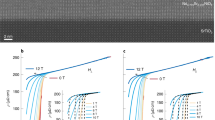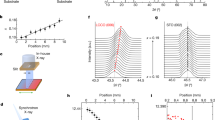Abstract
The mechanism of high-transition-temperature (high-Tc) superconductivity in doped copper oxides is an enduring problem. Antiferromagnetism is established as the competing order1,2, but the relationship between the two states in the intervening ‘pseudogap’ regime has become a central puzzle3. The role of the crystal lattice, which is important in conventional superconductors, also remains unclear. Here we report an anomalous increase of the distance between copper oxide planes on cooling, which results in negative thermal volume expansion, for layered ruthenium copper oxides4,5 that have been doped to the boundary of antiferromagnetism and superconductivity. We propose that a crossover between these states is driven by spin ordering in the ruthenium oxide layers, revealing a novel mechanism for negative lattice expansion in solids. The differences in volume and lattice strain between the distinct superconducting and antiferromagnetic states can account for the phase segregation phenomena found extensively in low-doped copper oxides, and show that Cooper pair formation is coupled to the lattice. Unusually large variations of resistivity with magnetic field are found in these ruthenium copper oxides at low temperatures through coupling between the ordered Ru and Cu spins.
This is a preview of subscription content, access via your institution
Access options
Subscribe to this journal
Receive 51 print issues and online access
$199.00 per year
only $3.90 per issue
Buy this article
- Purchase on Springer Link
- Instant access to full article PDF
Prices may be subject to local taxes which are calculated during checkout



Similar content being viewed by others
References
Kang, H. J. et al. Antiferromagnetic order as the competing ground state in electron-doped Nd1.85Ce0.15CuO4 . Nature 423, 522–525 (2003)
Hinkov, V. et al. Two-dimensional geometry of spin excitations in the high-transition-temperature superconductor YBa2Cu3O6+x . Nature 430, 650–654 (2004)
Orenstein, J. & Millis, A. J. Advances in the physics of high-temperature superconductivity. Science 288, 468–474 (2000)
Felner, I., Asaf, U., Levi, Y. & Millo, O. Coexistence of magnetism and superconductivity in R1.4Ce0.6RuSr2Cu2O10-delta (R = Eu and Gd). Phys. Rev. B 55, R3374–R3377 (1997)
Noce, C. & Vecchione, A., Cuoco, M. & Romano, A. (eds) Ruthenate and Rutheno-Cuprate Materials (Springer, Berlin, 2002)
Bernhard, C. et al. Coexistence of ferromagnetism and superconductivity in the hybrid ruthenate-cuprate compound RuSr2GdCu2O8 studied by muon spin rotation and dc magnetization. Phys. Rev. B 59, 14099–14107 (1999)
Lynn, J. W., Keimer, B., Ulrich, C., Bernhard, C. & Tallon, J. L. Antiferromagnetic ordering of Ru and Gd in superconducting RuSr2GdCu2O8 . Phys. Rev. B 61, 14964–14967 (2000)
van Schilfgaarde, M., Abrikosov, I. A. & Johansson, B. Origin of the Invar effect in iron-nickel alloys. Nature 400, 46–49 (1999)
Kiyama, T., Yoshimura, K., Kosuge, K., Ikeda, Y. & Bando, Y. Invar effect of SrRuO3: itinerant electron magnetism of Ru 4d electrons. Phys. Rev. B 54, R756–R759 (1996)
Sleight, A. Zero-expansion plan. Nature 425, 674–676 (2003)
Arvanitidis, J., Papagelis, K., Margadonna, S., Prassides, K. & Fitch, A. N. Temperature-induced valence transition and associated lattice collapse in samarium fulleride. Nature 425, 599–602 (2003)
Salvador, J. R., Guo, F., Hogan, T. & Kanatzidis, M. G. Zero thermal expansion in YbGaGe due to an electronic valence transition. Nature 425, 702–705 (2003)
McLaughlin, A. C., Attfield, J. P. & Tallon, J. L. A variable temperature structural study of the ferromagnetic superconductor RuSr2GdCu2O8 . Int. J. Inorg. Mater. 2, 95–99 (2000)
Shi, L., Li, G., Fan, X. J., Feng, S. J. & Li, X.-G. Structural, transport and magnetic properties of RuSr2Sm1.4Ce0.6Cu2O10-δ . Physica C 399, 69–74 (2003)
Emery, V. J. & Kivelson, S. A. Importance of phase fluctuations in superconductors with small superfluid density. Nature 374, 434–437 (1995)
Yanase, Y. & Yamada, K. Theory of pseudogap phenomena in high-T-c cuprates based on the strong coupling superconductivity. J. Phys. Soc. Jpn 68, 2999–3015 (1999)
Chmaissem, O., Jorgensen, J. D., Shaked, H., Dollar, P. & Tallon, J. L. Crystal and magnetic structure of ferromagnetic superconducting RuSr2GdCu2O8 . Phys. Rev. B 61, 6401–6407 (2000)
Matsukawa, M. et al. Stretched exponential behaviour in remanent lattice striction of a (La,Pr)1.2Sr1.8Mn2O7 bilayer manganite single crystal. Phys. Rev. B 70, 132402 (2004)
Chen, X. H. et al. Transport properties and specific heat of RuSr2GdCu2O8 and RuSr2Gd1.4Ce0.6Cu2Oy in magnetic fields. Phys. Rev. B 63, 064506 (2001)
Awana, V. P. S., Ichihara, S., Karppinen, M. & Yamauchi, H. Comparison of magneto-superconductive properties of RuSr2GdCu2O8-δ and RuSr2Gd1.5Ce0.5Cu2O10-δ . Physica C 378, 249–254 (2002)
McCrone, J. E. et al. Magnetotransport properties of doped RuSr2GdCu2O8 . Phys. Rev. B 68, 064514 (2003)
Ando, Y., Lavrov, A. N. & Komiya, S. Anisotropic magnetoresistance in lightly doped La2-xSrxCuO4: Impact of antiphase domain boundaries on the electron transport. Phys. Rev. Lett. 90, 247003 (2003)
Lavrov, A. N. et al. Spin-flop transition and the anisotropic magnetoresistance of Pr1.3-xLa0.7CexCuO4: unexpectedly strong spin-charge coupling in the electron-doped cuprates. Phys. Rev. Lett. 92, 227003 (2004)
Rao, C. N. R. & Raveau, B. (eds) Colossal Magnetoresistance, Charge Ordering and Related Properties of Manganese Oxides (World Scientific, Singapore, 1998)
Tokura, Y. (ed.) Colossal Magnetoresistive Oxides (Gordon and Breach Science, New York, 2000)
Kobayashi, K. L., Kimura, T., Sawada, H., Terakura, K. & Tokura, Y. Room-temperature magnetoresistance in an oxide material with an ordered double-perovskite structure. Nature 395, 677–680 (1998)
Cuk, T. et al. Coupling of the B1g phonon to the antinodal electronic states of Bi2Sr2Ca0.92Y0.08Cu2O8+δ . Phys. Rev. Lett. 93, 117003 (2004)
Ahn, K. H., Lookman, T. & Bishop, A. R. Strain-induced metal–insulator phase coexistence in perovskite manganites. Nature 428, 401–404 (2004)
Mclaughlin, A. C., Zhou, W., Attfield, J. P., Fitch, A. N. & Tallon, J. L. The structure and microstructure of the ferromagnetic superconductor RuSr2GdCu2O8 . Phys. Rev. B 60, 7512–7516 (1999)
Mclaughlin, A. C., Attfield, J. P., Asaf, U. & Felner, I. Chemical control of hole-doped superconductivity and magnetism in Gd2-xCexRuSr2Cu2O10-δ . Phys. Rev. B 68, 014503 (2003)
Acknowledgements
We thank P. Littlewood, P. Monthoux and N. Mathur for discussions, and P. Henry and E. Suard for assistance with the neutron experiments. We also acknowledge the Royal Society of Edinburgh for a SEELLD research fellowship (A.C.M.), the Ministry of Science and Technology, Government of Pakistan for a studentship (F.S.), and the UK EPSRC for beam time provision and financial support.
Author information
Authors and Affiliations
Corresponding author
Ethics declarations
Competing interests
Reprints and permissions information is available at npg.nature.com/reprintsandpermissions. The authors declare no competing financial interests.
Supplementary information
Supplementary Tables
Two tables containing refinement parameters and derived quantities such as bond distances for RuSr2Nd0.9 Ce0.9Y0.2Cu2O10, from slow warming neutron diffraction data at temperatures from 4 to 290 K. (DOC 37 kb)
Supplementary Figures
Figures S1-S6, showing profile fits and magnetic peak variations from the neutron diffraction analysis of RuSr2Nd0.9 Ce0.9Y0.2Cu2O10 and other ruthenocuprates; also magnetisation and magneto-transport data for RuSr2Nd0.9 Ce0.9Y0.2Cu2O10. (DOC 968 kb)
Rights and permissions
About this article
Cite this article
Mclaughlin, A., Sher, F. & Attfield, J. Negative lattice expansion from the superconductivity–antiferromagnetism crossover in ruthenium copper oxides. Nature 436, 829–832 (2005). https://doi.org/10.1038/nature03828
Received:
Accepted:
Issue Date:
DOI: https://doi.org/10.1038/nature03828
This article is cited by
-
The role of average atomic volume in predicting negative thermal expansion: The case of REFe(CN)6
Science China Materials (2022)
-
Magnetic fluctuations driven insulator-to-metal transition in Ca(Ir1−xRux)O3
Scientific Reports (2015)
-
Correction: Negative lattice expansion from the superconductivity–antiferromagnetism crossover in ruthenium copper oxides
Nature (2005)
Comments
By submitting a comment you agree to abide by our Terms and Community Guidelines. If you find something abusive or that does not comply with our terms or guidelines please flag it as inappropriate.



